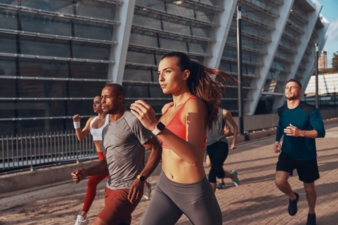27.03.24 – Sports inspired clothing market
The influence of sports on fashion forward looks
The global sports inspired clothing market is forecast to expand at a CAGR of 5.3% and thereby increase from a value of US$ 315.03b in 2023, to US$ 452.2b by the end of 2030 as per report published by Persistence Market Research.
Divining market growth factors
Firstly, the rising popularity of athleisure and casual wear drives market expansion within the Sports-Inspired Clothing segment. As consumers prioritize comfort, versatility, and lifestyle-oriented fashion choices, sports-inspired apparel emerges as a favored option for everyday wear, leisure activities, and social occasions. Athleisure wear blurs the boundaries between activewear and streetwear, offering consumers functional garments that transition seamlessly from the gym to the office to social gatherings, fueling market demand for sports-inspired clothing lines and collections. Secondly, collaborations between sportswear brands, fashion designers, and celebrities propel market growth and product innovation in the sports inspired clothing industry. Sportswear brands partner with high-profile athletes, influencers, and fashion icons to create limited-edition collections, capsule collaborations, and exclusive releases that blend athletic performance with fashion-forward aesthetics. These collaborations generate buzz, drive brand visibility, and attract new consumers to sports-inspired clothing, leveraging the appeal of celebrity endorsements and trend-setting styles to capture market share and consumer loyalty. Moreover, advancements in textile technology, fabric innovation, and sustainable materials shape market dynamics and product differentiation in the Sports-Inspired Clothing segment. Apparel manufacturers invest in research and development to develop performance fabrics with moisture-wicking properties, stretch capabilities, and thermal regulation features, enhancing comfort and functionality in sports-inspired garments. Additionally, the adoption of sustainable materials, such as recycled polyester, organic cotton, and eco-friendly dyes, addresses consumer demand for environmentally conscious fashion choices, driving market adoption and sustainability initiatives in the fashion industry.
Redefining fashion with active lifestyle trends
The sports-inspired clothing market is experiencing dynamic growth, fueled by the fusion of athletic wear with casual and fashion-forward styles, as well as the increasing popularity of active lifestyles among consumers worldwide. As individuals seek versatile, comfortable, and performance-driven apparel for both athletic pursuits and everyday wear, the sports-inspired clothing market presents numerous opportunities for brands and retailers to innovate and cater to the evolving preferences and needs of consumers. One significant opportunity within the sports-inspired clothing market lies in meeting the demand for athleisure apparel that seamlessly combines style, comfort, and performance features for a wide range of activities and occasions. With consumers increasingly prioritizing versatility and functionality in their clothing choices, there is growing demand for athleisure wear that transitions effortlessly from the gym to the street, from work to leisure, and from day to night. Brands can capitalize on this trend by offering athleisure collections that feature innovative materials, ergonomic designs, and performance-enhancing features such as moisture-wicking, stretchability, and breathability. By incorporating fashion-forward designs, on-trend colors, and stylish silhouettes into their athleisure offerings, brands can appeal to consumers seeking both performance and aesthetics in their clothing choices, driving increased adoption and market growth in the sports-inspired fashion segment.
In conclusion, the sports inspired clothing market is witnessing a significant trend wherein athleisure apparal combines performance features with fashion, catering to diverse occasions and driving demand for stylish and yet functional sportswear. Additionally, the market is influened by sports endorsements and collaborations, with celebrities and influencers partnering with brands to design exclusive collections and promote them through social media, contributing to brand differentiation and market growth. However, the industry faces challenges related to sustainability, competition, and consumer preferences, necessitating investments in eco-friendly practices and brand differentiation strategies to stay relevant. Recent developments include innovation in materials and manufacturing processes for sustainability, as well as a focus on digitalization and omnichannel retailing to enhance customer engagement and drive online sales.

